|
A Consideration of Humphrey's "Cerebral Sentient Loop" Explanation of Consciousness from "A History of the Mind" by Nicholas Humphrey
MAX BENNETT
The evolution of the nervous system may have started a thousand millions years ago with the sponges or just six hundred and fifty million years ago with polyps like jelly-fish and corals. Sponges are extremely simple multicellular organisms (Figure 1A). A section through a sponge, when stained with silver, shows some cells that connect one side of the body wall of the animal to the other (Figure 1B); it has been claimed that these may be primitive nerve cells. With the evolution of the Colenterates, such as hydra, jelly-fish and corals, the identification of nerve cells and muscles is unequivocal: jelly fish have two layers of cells with a jelly-like substance seperating the two, giving the animal some rigidity (Figure 2A). Nerve nets for the control of swimming, tentacle position and feeding are composed of either bipolar or multipolar neurones (Figure 2B). These nerve nets come together in integrating centres, where a mixture of both neurone types may be found (Figures 2C and 2D); these centres are known as ganglia.
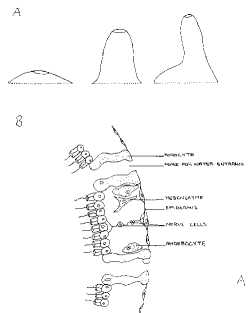 |
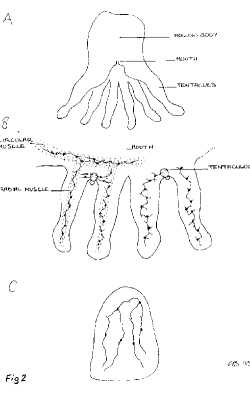 |
| Figure 1. [Click image to enlarge] The Porifera or sponges are very simple multicellular parasites. They do not possess a nervous system and it is controversial as to whether they have any neurones. In A is shown the simple motor reactions of the fresh water sponge Ephydrata, with the mouth chimney changing its' form as water is drawn into the body through small pores and passed out through the mouth. In B is shown some of the cell types that stain with silver in the sponge Sycon Raphanus; the outer surface is connected to the inner surface by two cells with long and thin processes that may be nerve cells; the cells on the inner surface are collar cells ( called choanocytes). |
Figure 2. [Click image to enlarge] The Colenterates or polyps like hydra, jelly-fish, sea-anemones and corals have a sack-like body with tentacles as shown in A. In B are shown the two different kinds of neurone networks present in Aurells Aurata: one is composed of neurones that possess two axons (bipolar neurones ) and these are promenent in relation to the radial and circular muscles that are exposed in this drawing; the other is composed of neurones with more than two processes (multipolar neurones) and these are shown in relation to the gastric cavity. Both bipolar and multipolar neurones from each nerve net are apposed to each other in collections on neurones called ganglia, as shown in C; here the input to the bipolar cells a2sociated with the muscle is transferred to the multipolar neurones associated with the gastric cavity. This collection of neurones into a ganglion for the purposes of neural integration occurs for the first time in the Coelenterates. |
A very large increase in the complexity of the nervous system occurs with the appearance of the flatworms (Figure 3). In this case the ganglia are fewer in number and concentrated at one end of the animal, which may be distinguished as the head for primitive eyes and mouth are found there (Figure 3) This is the first sign of the head ganglia which are eventually destined to evolve in their most complex form into the brain of Homo Sapiens (Figure 4), which receives sensory information from nerve receptors in different areas of the skin called dermatomes (numbered in Figure 4) as well as from the distance receptors such as the eyes, ears and nose.
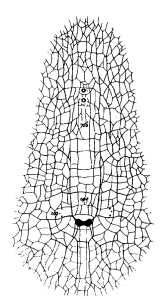 |
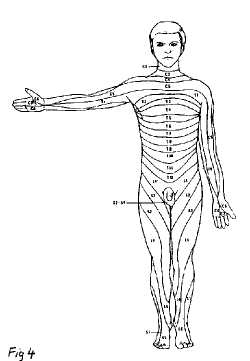 |
| Figure 3. [Click image to enlarge] The grouping of large numbers of neurones into an integrating centre or ganglion. which is not symmetrically placed in the animal, first occurs in the Platyhelminthes or flatworms. Shown here is the dorsal nerve plexus of Notoplana Atomata( Polycladida) converging on the head ganglion. The labels refer to the 'gpl' (genital nerve plexus), hdn' (posterior dorsal nerve) and 'tau' (tentacle eyes). |
Figure 4. [Click image to enlarge] The grouping of neurones into a head ganglion that provides an integrating centre for the nervous system reaches its' most complex level of evolution in the brain of Homo Sapiens. Shown are the individual areas of skin, each subserving a different set of neurones, that bring information to the brain concerning such sensations as touch, pressure, temperature and pain. The individual areas are labelled C2 to C5 (cervical spinal cord levels 1 to 5), TI to T12 (thoracic spinal cord levels 1 to 12), Ll to L5 (lumbar spinal cord levels 1 to 5) and S I to S4 (sacral spinal cord levels 1 to 4). Nerves enter the spinal cord at each of these levels C2 to S4. |
Nicholas Humphrey, until recently Director of the Unit of Animal Behaviour at Cambridge University, has written a book called " A History of the Mind". Humphrey argues that in the most primitive animals, such as jelly fish, the nerve nets convey information from the body wall concerning sensory phenomenon such as touch towards the ganglia which then issue an outgoing signal for the muscles of the body wall to respond, for example with a contraction giving a wriggle (Figure 5A). Humphrey goes on to suggest that with further evolution of the nervous system the outgoing signal to the muscles of the body wall in response to an incoming sensory signal became modified so as to actually alter the incoming signal as well as to contract the muscles (Figure 5B); this collateral effect, of the outgoing motor nerves altering the signal arriving along the sensory nerves, may even be present in the early evolved nervous system of flatworms. Indeed an even further degree of collateralization can occur in which the motor collateral can give rise to sensory experiences independent of any incoming sensory signals (Figure 5C). Another form of collateralization involves the outgoing motor signal in response to a sensory input modifying the incoming sensory signal, without actually contracting muscles at all (Figure 5D); these collaterals can be used to sustain the sensory experience well after the actual event that gave rise to the initial sensation has passed. This ability to maintain a sensation at will by using the collateralization effect is called 'sustaining the sentient loop'. The final evolution of this process, according to Humphrey, probably only occurs in the higher mammals. It involves the motor output that has been modified to only change an incoming sensory signal now gedrating and sustaining sensory signals itself within the brain in the absence of any sensory input (Figure 5E). The nervous system is in this way able to voluntarily generate sensations and maintain them at will. It is this ability to use the sentient loop that is the highest form of consciousness.
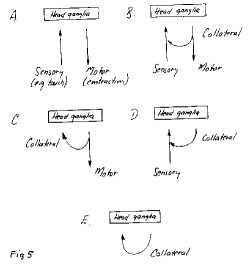 |
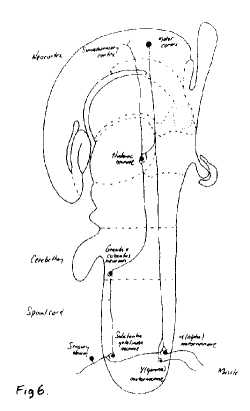 |
| Figure 5. [Click image to enlarge] Evolution of the 'sentient' loop according to Humphrey. A: during evolution a most elemental form of nervous system consists of sensory neurones bringing in information, concerning for example touch and pressure, to an integrating centre consisting of a large number of interconnected neurones constituting a head ganglion; this then issues motor command to contract an appropriate muscle given the type of sensory information received by the head ganglion. B: the next level of sophistication was reached with the appearance of collateral nerve branches emanating from the outgoing motor nerves and ending in relation to the incoming sensory nerves; in this way the motor command was able for the first time to modify the sensory input to the head ganglion (see Figure 6 for an example of this process). C: these collaterals then became modified in two important ways, one of which is shown here; on issuing a motor command the collateral is able to induce a sensory experience independent of any input to the head ganglion along the sensory nerves themselves (see Figure 7 for an example of this process). D: the other important way in which the collaterals became modified is that they could be used to modify incoming sensory signals independently of any motor signals at all (see Figures 8B and 11 for examples of this process). E: the final level of sophistication involves the appearance during evolution of the 'sentient loop', in which the collateral acts on its own without any motor command being issued or sensory information about the environment being received; the head ganglion or brain can in this way generate its own sensory experiences, and it is this process that constitutes consciousness ( for an example of the brain generating activity in a voluntary way, without motor or sensory activity, see Figure 11). |
(责任编辑:泉水)
------分隔线----------------------------
|






